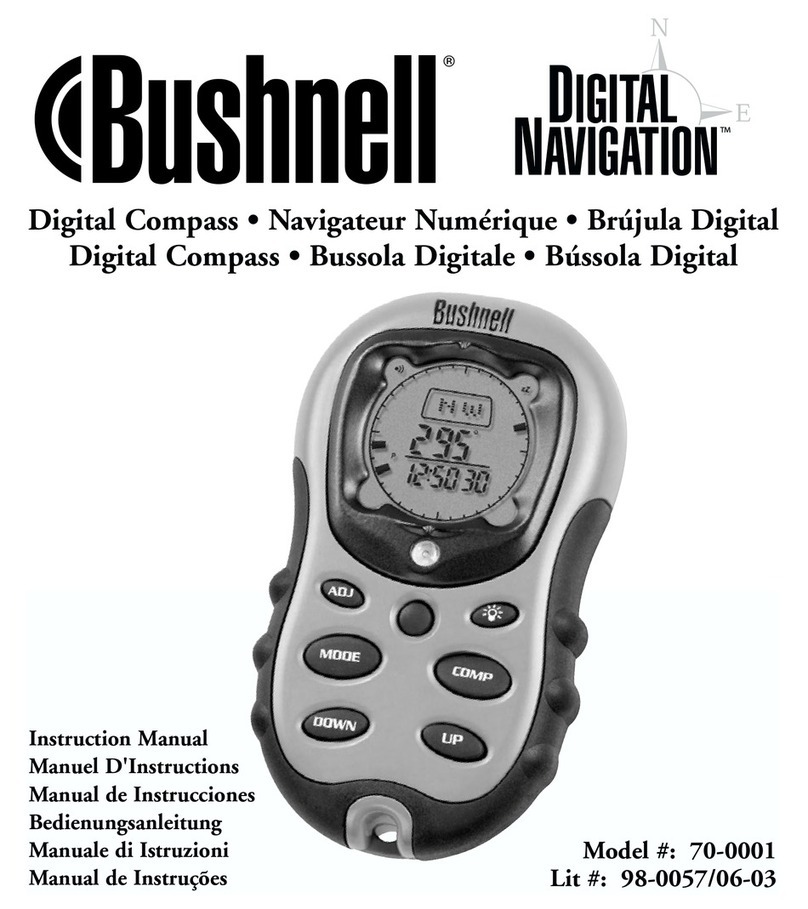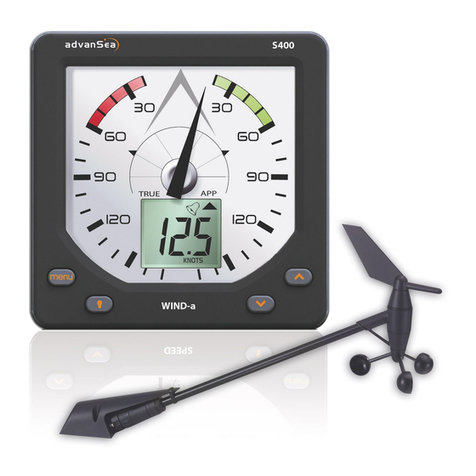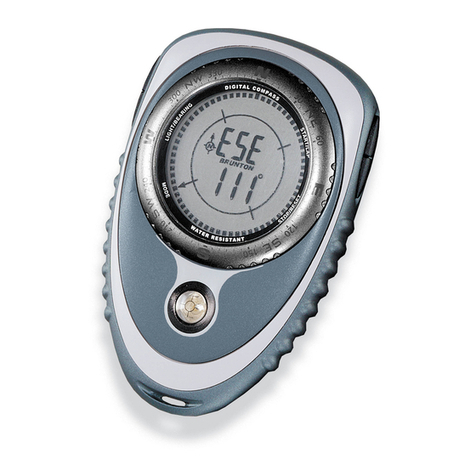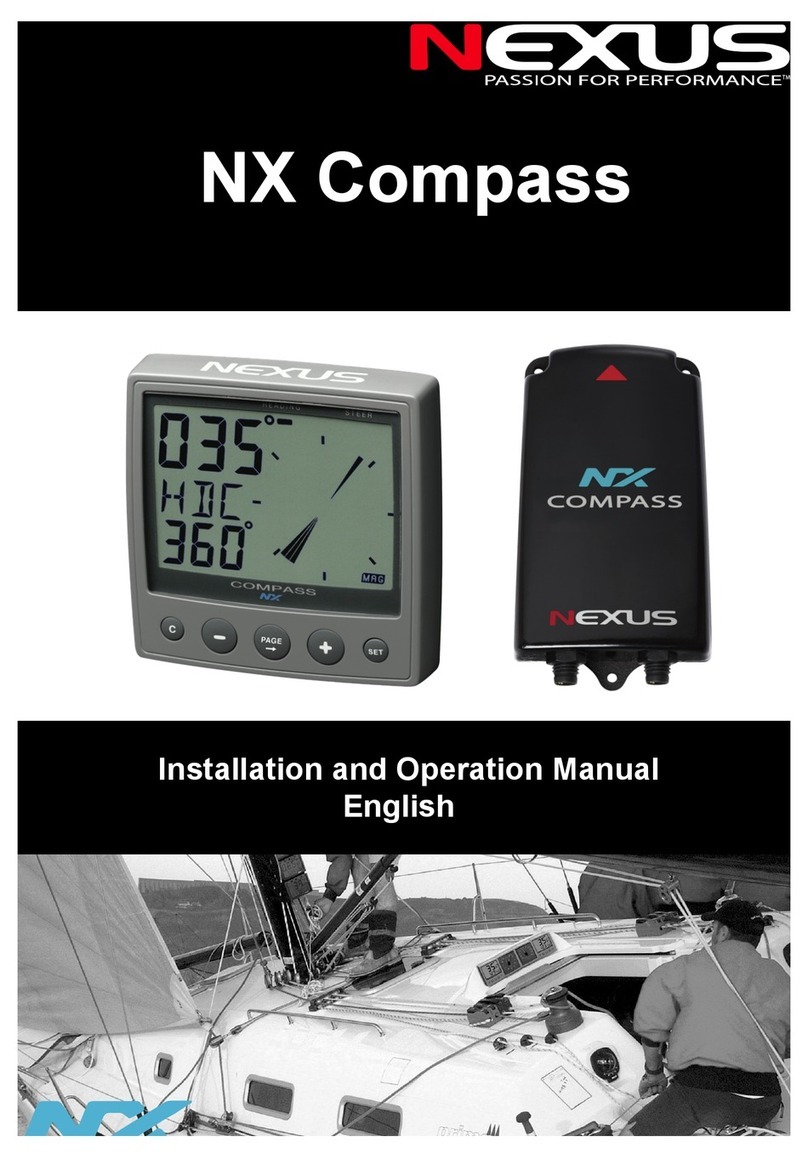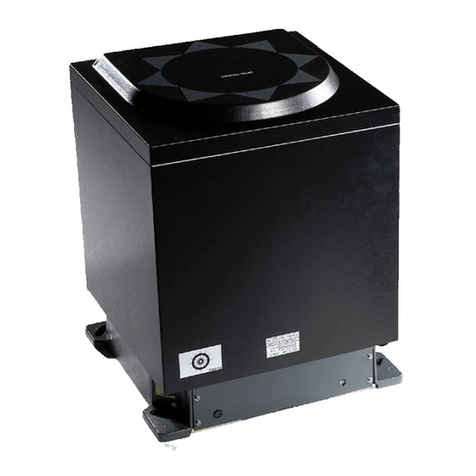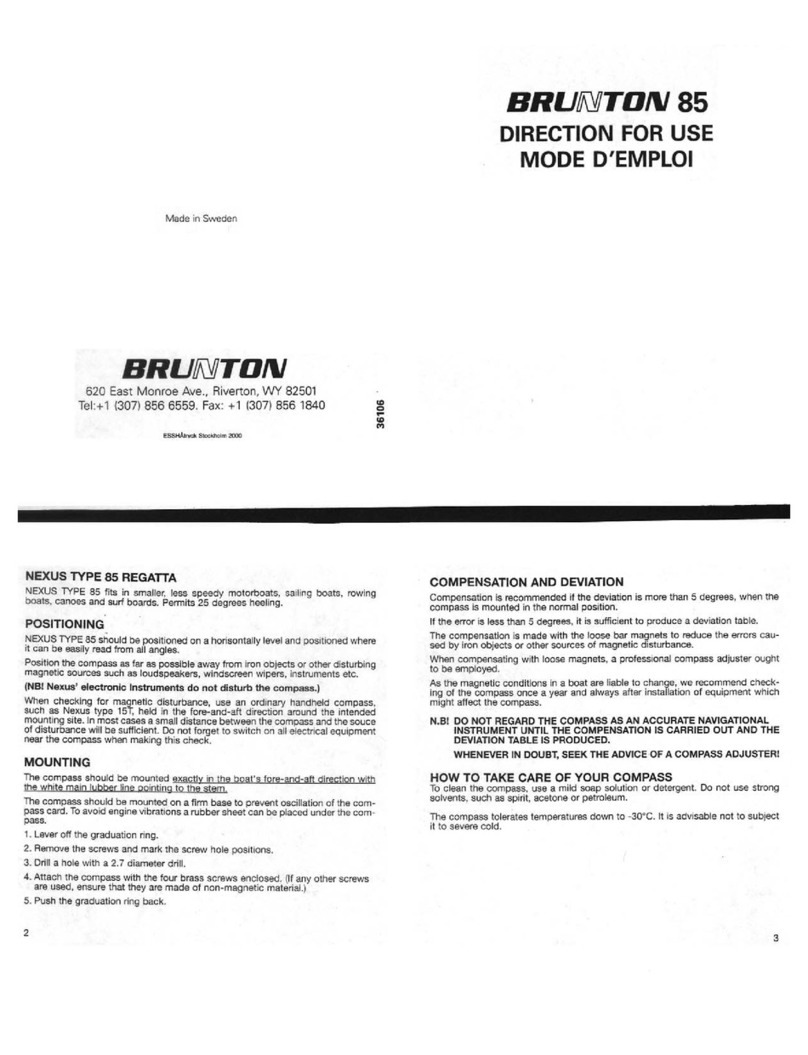Foshk WS112 User manual

1
DIGITAL COMPASS
Instruction Manual
1. Introduction
1.1 Features:
zDigital compass
zTemperature (℃or ℉)
z12/24 clock format
zCalendar
zTime and date by manual setting
zLanyard included for easy carrying
1.2 LCD display
The following illustration shows the full segment of the LCD for description purpose only and
will not appear like this during normal operation.
1.3 Insert battery 1). First use a large coin to open the battery cover at the
back of the anemometer.
2). Checking the correct polarization, insert 1 x 3V
(CR2032) lithium cell, positive (+) pole up into the
battery compartment and replace the cover.
3). When the battery is inserted, all the segments of the
LCD and backlight will light up briefly.
Caution: Do not reverse polarity of the batteries
Time / Date
Compass
Temperature

2
Wait 10 seconds before re-insert the battery again to make a proper reset
2. Precautions when using the Compass
zKeep your digital compass away from magnets or appliances which may contain
magnetic objects, such as: mobile phones, speakers, motors, etc.
zThis compass like most magnetic compasses, points to the magnetic North, which is
slightly difference from the true North. Check section ‘3.4 Magnetic Declination’ for more
information.
zTo achieve a accurate result, you should avoid measuring a direction on the following
conditions:
The compass is too close to magnetic objects
The compass is too close to metal objects
The compass is too close to an electrical appliance.
The compass is inside a moving object or a concrete building
3. Magnetic Declination
3.1 What is Magnetic Declination - The Magnetic North Pole is slightly difference
from the True North Pole. Most magnetic
compasses, point to the Magnetic North Pole. On
the contrary, everything measured from a map is
related to the True North Pole.
- The angular difference between Magnetic North
Pole and True North Pole is called magnetic
declination. Its amount (degrees and minutes) and
direction (easterly and westerly) depend on where
you are.
- For serious compass user or users who intends to
perform accurate navigation, the compass must be
adjusted to compensate for magnetic declination.
3.2 Magnetic Declination Information
- Most topographic maps show magnetic north pole and or the magnetic declination
information.
- The manual includes the magnetic declination for some major cities. Check the ‘Magnetic
Declination at Major Cities’ section for more detail.
- For those cities whose names are not included in the list, you may like to refer to the online
magnetic declination information.
3.3 Magnetic Declination Compensation
- compensate an object’s bearing by subtract westerly (W) magnetic declination or add
easterly (E) magnetic declination with the magnetic bearing.
Example
- 26° Westerly magnetic declination and the compass needle points 326° (MB).
- The true bearing will be 326°(MB)-26°(W) = 300°

3
compass will compensate the compass bearing wherever the magnetic declination is either
westerly declination or Easterly declination automatically, if the user inputs the magnetic
declination angle of the city which is close to the user’s current location during the calibration.
Check the 4.5 Calibrating the compass section for more details on the calibration.
3.4 Magnetic Declination at Major Cities
No.
Country/Place Major City Declinatio
n No.
Country/Place Major City Declinati
on
1 Afghanistan Kabul 2-E 33 Netherlands Amsterdam 1-W
2 Australia Canberra 12-E 34New Zealand Wellington 22-E
3 Austria Vienna 2-E 35Norway Oslo 0
4 Bahrain Manama 2-E 36Pakistan Islamabad 2-E
5 Bangladesh Dhaka 0 37Philippines Manila 1-W
6 Belgium Brussels 1-W 38Portugal Lisbon 5-W
7 Brazil Brasilia 19-W 39Russia Moscow 9-E
8 Canada Ottawa 14-W 40Singapore Singapore 0
9 Chile Santiago 5-E 41South Africa Cape Town 23-W
10China Beijing 6-W 42Spain Madrid 3-W
11China Hong Kong 2-W 43Sweden Stockholm 3-E
12Costa Rica San Jose 0 44Switzerland Bern 0
13Cuba Havana 3-W 45Taiwan Tai-pei 3-W
14Czech
Republic Prague 2-E 46Thailand Bangkok 0
15denmark Copenhage
n 1-E 47UAE Abu Dhabi 1-E
16Egypt Cairo 3-E 48United
Kingdom London 3-W
17Finland Helsinki 6-E 49United States Washington,
DC 10-W
18France Paris 1-W 50 Juneau 25-E
19Germany Berlin 1-E 51 Phoenix 12-E
20Greece Athens 3-E 52 Little Rock 2-E
21Hungary Budapest 4-E 53 Sacramento 16-E
22India New Delhi 1-E 54 Denver 10-E
23Indonesia Jakarta 1-E 55 Atlanta 4-W
24Isreal Jerusalem 3-E 56 Honolulu 10-E
25Italy Rome 1-E 57 Boston 16-W
26Japan Tokyo 7-W 58 Saint Paul 2-E
27Jordan Amman 3-E 59 Jackson 1-E
28Kenya Nairobi 1-E 60 Santa Fe 10-E
29Korea Seoul 7-W 61 Oklahoma City 6-E
30Malaysia Kuala
Lumpur 1-E 62 Salem 18-E
31Mexico Mexico City 6-E 63 Harrisburg 11-E
32Nepal Katmandu 0 64 Slat Lake City 14-E

4
4. Program Modes
The compass has two keys for easy operation: SET key, COMPASS key.
4.1 SET Mode
- While in normal display, press “SET” button to shift the display of time and date
- While in normal display, hold the “SET” button for 3s to enter setting mode
- Press “ SET” button to select the following setting in sequence:
z12/24 hour format
zManual time setting (hours/minutes)
zCalendar setting (year/month/date
zTemperature display unit degree Celsius or Fahrenheit
In the above setting modes, press “COMPASS” button to change or scrolls the value. Hold the
“COMPASS” button for 3 second will increase/decrease digits in great steps. Press the “SET”
button to accept the change and advance to the next setting mode. Continue to press the
“SET” button to toggle through the setting mode until return to the normal Mode
4.2 The “COMPASS/-” Mode
- While in normal display, press “COMPASS/-” button to enter compass mode
-While in compass mode, press “COMPASS/-” to shift the display of the bearing direction in
compass points and in digital.
- Hold the “COMPASS” button for 3s to enter Calibration mode.
5. Compass Calibration mode
5.1 Perform the compass calibration in the following conditions:
1) When the compass is used the first time
2) The battery has been replaced,
3) When using the compass in a location different from the place in which the compass had
been calibrated.
5.2 Calibration procedure:
1) Hold the “COMPASS” button until “CAL” is shown on the display, which indicates the
calibration screen.
2) Hold the compass a flat surface which is parallel to the horizon, then rotate the compass
North
indicator
Cardinal
indicator
North
indicator
Bearing in
degrees

5
clockwise for 1-2 turns. The rotation should be completed in a slow and steady practice
(around 20s per one turn).
3) When the turning is completed, press “SET” button to enter the Magnetic Declination
mode
4) The “DEC” indicator is shown on the display. The digit will start flashing.
5) Press “COMPASS” button to increase the angle (from -90 to 90), until the desire magnetic
declination has appeared.
NOTE:
Check section “3.4 Magnetic Declination at Major Cities” to get the magnetic declination of the
city nearest to your current position. Input this angle into the compass during the calibration
Example 1:
Compensate the magnetic declination for Wellington in New Zealand (22-E), select +22 in the
magnetic declination setting.
Example 2:
Compensate the magnetic declination for Lisbon in Portugal (5-W), select -5 in the magnetic
declination setting:
Note: 1. the compass must be kept in a level position when in use.
2. Compass readings are easily affected by disturbing sources of magnetism, so the
compass should always be used in the open air.
6. Specification
zCompass range : 0° to 359°
1 to 16 pointers (graphical)
zAngeraccuracy : +/-8°
zTemperaturerange : -20℃to +60℃(-4℉to +140℉)
zTemperatureaccuracy : +/-1.0℃
zMeasuring temperature interval l : 15 sec
Power consumption
Single 3V lithium battery (CR2032)
Battery life: Minimum 6 months at normal display mode
